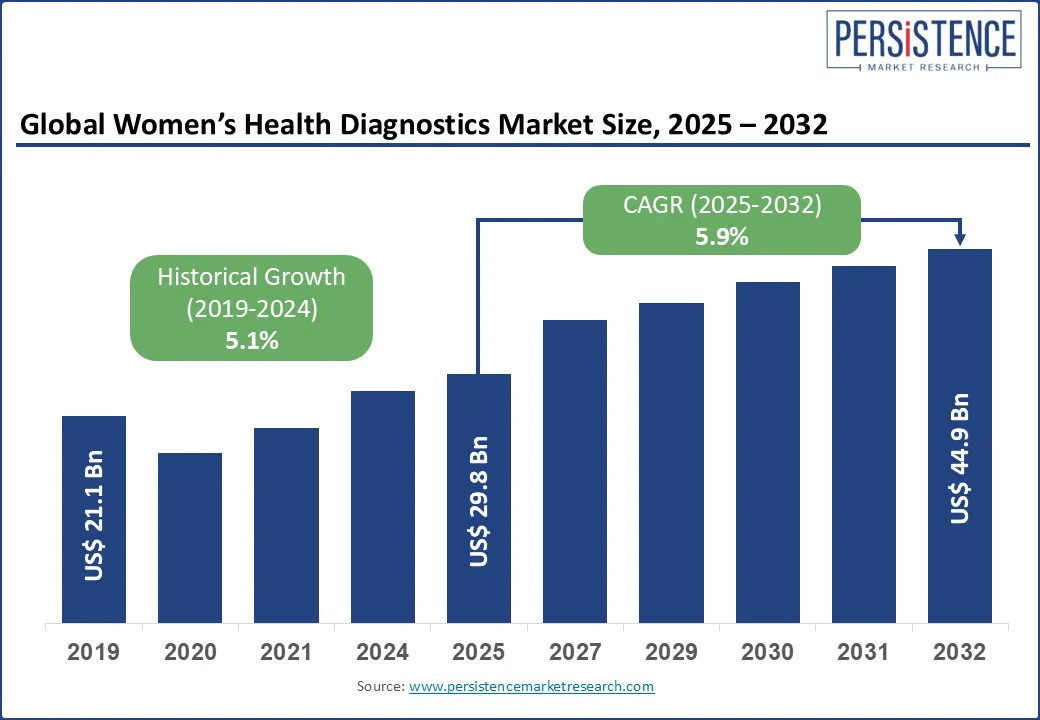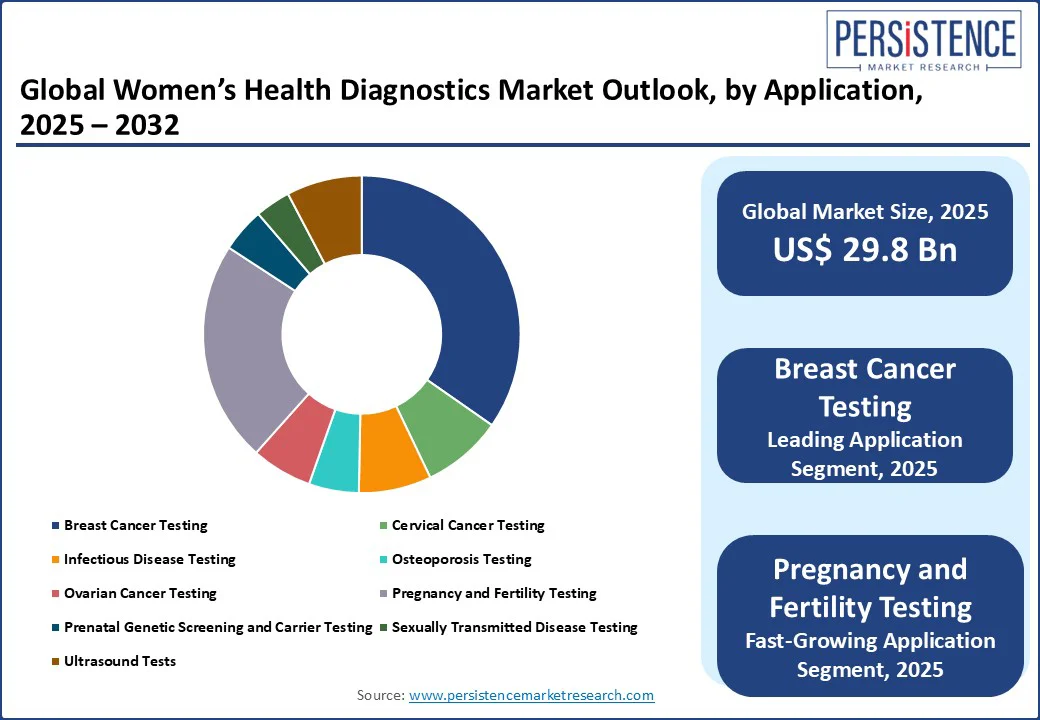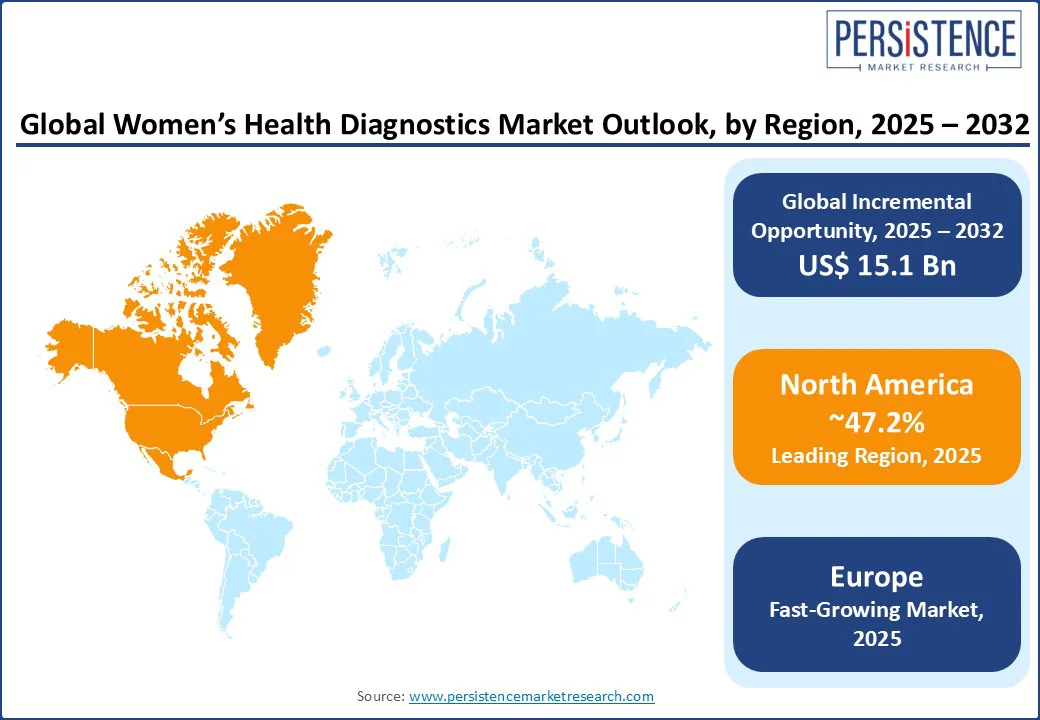ID: PMRREP14560| 178 Pages | 12 Aug 2025 | Format: PDF, Excel, PPT* | Healthcare

The women’s health diagnostics market size is likely to be valued at US$ 29.8 Bn in 2025 and is estimated to reach US$ 44.9 Bn in 2032, growing at a CAGR of 5.9% during the forecast period 2025-2032. Women’s health diagnostics is supported by shifting demographic trends, increasing clinical awareness, and the rise of consumer-led healthcare. As diagnostic technologies evolve from lab-based protocols to patient-centric solutions, the market is witnessing skyrocketing demand across fertility, cancer, and hormonal testing segments. Leading players are capitalizing on this trend through AI-enabled screening tools, mobile health integrations, and targeted outreach to underserved populations.

Key Industry Highlights:
|
Global Market Attribute |
Key Insights |
|
Women’s Health Diagnostics Market Size (2025E) |
US$ 29.8 Bn |
|
Market Value Forecast (2032F) |
US$ 44.9 Bn |
|
Projected Growth (CAGR 2025 to 2032) |
5.9% |
|
Historical Market Growth (CAGR 2019 to 2024) |
5.1% |
The emergence of various women’s health apps is augmenting the women’s health diagnostics market growth worldwide. These apps help raise awareness, enable self-monitoring, and link users directly to testing options. Apps such as Flo, Clue, and Natural Cycles are no longer just period trackers. They now provide features, including ovulation prediction, symptom logging, fertility insights, and referrals to diagnostic services. These platforms are also integrating with at-home testing services, making diagnostics more accessible and less intimidating.
The rise of menopause-focused apps is opening a previously underserved area of diagnostics. Tools such as Balance and Midday cater to women navigating perimenopause and menopause by recommending hormonal and metabolic tests based on logged symptoms. AI is further improving diagnostic relevance by optimizing personalization in these apps. Hormona, a Sweden-based start-up, uses AI to analyze monthly hormonal fluctuations and flags abnormalities that require diagnostic confirmation.
The high cost of novel treatments is discouraging timely diagnostic uptake in women’s health. It is evident in cases where positive results often lead to therapies that are financially inaccessible. For example, advanced treatments for HER2-positive breast cancer or endometriosis tend to cost thousands of dollars annually. This financial burden often causes women in low- and middle-income groups to delay or avoid diagnostic tests, fearing they cannot afford follow-up care. A 2023 survey by the Kaiser Family Foundation found that 22% of U.S. women skipped recommended cancer or reproductive health screenings due to estimated treatment expenses.
The psychological impact of diagnosis also plays a key role in suppressing diagnostic engagement. Conditions, including infertility, PCOS, or HPV infection, carry a heavy emotional toll, often linked with stigma, anxiety, or fear of life-changing outcomes. Research published in the Journal of Psychosomatic Research in 2024 showed that over 30% of women who tested positive for high-risk HPV experienced moderate to severe anxiety. It resulted in decreased compliance with follow-up colposcopies or PAP tests.
Increasing adoption of point-of-care (POC) and rapid diagnostic tests is creating new opportunities in the field of women’s health diagnostics. These tests are ideal in settings where traditional laboratory infrastructure is limited or turnaround time is important. For instance, in 2024, India’s National Health Mission introduced POC HPV and syphilis screening at primary health centers in rural districts. It helped in reducing referral delays and boosting screening rates among women aged 30 to 50 by 18% within six months.
Rapid diagnostics are also improving maternal and prenatal care. Devices, including Abbot’s i-STAT Alinity enable clinicians to assess key parameters such as hemoglobin, electrolytes, and lactate at the bedside. It is essential for managing conditions such as pre-eclampsia or anemia during pregnancy. Sexually Transmitted Infections (STIs), another key area of women’s health, are benefiting from rapid testing tools. These enable urgent care centers and sexual health clinics to provide same-day treatment, which is required to prevent complications such as pelvic inflammatory disease or infertility.
Based on application, the market is divided into breast cancer testing, cervical cancer testing, infectious disease testing, osteoporosis testing, ovarian cancer testing, pregnancy and fertility testing, prenatal genetic screening and carrier testing, sexually transmitted disease testing, and ultrasound tests. Out of these, breast cancer testing is poised to hold nearly 34.7% share in 2025 with increasing awareness about early detection and availability of unique diagnostic technologies. As per the National Breast Cancer Foundation, in 2025, an estimated 316,950 women will be diagnosed with invasive breast cancer. This alarming rise has prompted national health systems and private players to expand screening coverage and invest in improved testing solutions.
Pregnancy and fertility testing is emerging as a key application owing to rising infertility rates, delayed parenthood, and high demand for at-home diagnostics. According to the World Health Organization (WHO), around 1 in 6 individuals globally experience infertility. Rising maternal age, sedentary lifestyles, and environmental stressors are pushing women to seek early fertility assessments. It has bolstered a sharp increase in diagnostic testing for hormone levels, ovulation patterns, and ovarian reserve.
By end-use, the market is divided into hospitals, laboratories, homecare, and others. Among these, the homecare segment will likely account for around 29.6% of the women’s health diagnostics market share in 2025, with rising demand for privacy, convenience, and control over personal health. Women are demanding discreet and time-saving alternatives to clinic-based tests, specifically for conditions related to fertility, pregnancy, sexual health, and hormone imbalances. They also expect diagnostics to be part of a wholesome digital experience, thereby pushing demand.
Hospitals remain a prominent end-user, backed by their ability to deliver integrated care, especially for high-risk pregnancies, cancer diagnostics, and reproductive disorders. Complex cases such as triple-negative breast cancer, advanced endometriosis, or recurrent pregnancy loss often demand advanced imaging, biopsy, genetic testing, and follow-up. These are centralized in hospital systems. Hospitals are also early adopters of novel technologies, including AI-backed radiology, digital pathology, and multiplex molecular testing, further augmenting growth.

In 2025, North America is predicted to account for approximately 47.2% of share due to policy shifts, increasing adoption of preventive care, and rising consumer awareness. The U.S. women’s health diagnostics market is anticipated to dominate with government initiatives such as the Centers for Disease Control and Prevention’s (CDC) Inside Knowledge campaign. It promotes early detection of gynecologic cancers. In addition, insurance coverage under the Affordable Care Act mandates free screenings for breast and cervical cancer.
Such initiatives have propelled high testing volumes across states. As per the American Cancer Society, in 2023, nearly 79.8% of women aged 50 to 74 in the U.S. had a mammogram in the past two years. This shows a gradual return to preventive care post-pandemic. Digital platforms are further broadening access, specifically for rural and marginalized communities. U.S.-based Modern Fertility, acquired by Ro in 2021, for example, has extended its at-home testing kits for hormone levels, thyroid function, and ovarian reserve.
Europe’s market is being propelled by national screening programs, adoption of digital diagnostics across public health systems, and rising funding for female-specific health research. Sweden, Germany, and the Netherlands have implemented government-funded cervical and breast cancer screening programs. In 2023, the European Commission's Beating Cancer Plan allocated over €4 Bn to improve cancer screening across member states. It also emphasizes the improvement of screening rates for women aged 30 to 65.
The shift to HPV-based primary screening has surged in several countries. England, for instance, replaced Pap smear testing with HPV testing as the primary method in 2020. It has encouraged other countries such as Belgium and Ireland to move fully to HPV DNA testing, supported by the availability of Roche’s Cobas systems and similar automated platforms. Romania and Bulgaria are extending mobile diagnostic units that deliver free mammography and gynecological screenings in underserved rural areas. These initiatives are helping close long-standing regional gaps in women’s health access.
Asia Pacific is seeing uneven progress with Japan, South Korea, and Australia growing steadily, while others struggle with access and infrastructure gaps. Japan remains a regional leader, supported by government-backed programs and private sector involvement. In 2024, Takeda and Sysmex extended their partnership to include AI-backed cervical screening tools, targeting early detection in women over 30. South Korea has integrated breast and cervical cancer screening into its National Health Insurance Service.
Australia has shifted to HPV-based cervical screening. According to the Australian Institute of Health and Welfare (AIHW), the country witnessed a 50% reduction in cervical cancer incidence among women aged 25 to 39. This is attributed to the National HPV Vaccination Program (NHVP) and the National Cervical Screening Program (NCSP). In India, start-ups such as Niramai are using thermal AI imaging to deliver affordable and non-invasive breast cancer screening, primarily in Tier-2 and Tier-3 cities. In China, growth is being boosted by increasing government investment in preventive diagnostics and local development.

Key companies in the women’s health diagnostics market are focusing on early detection, personalized care, and access expansion. Leading players are heavily investing in AI-integrated imaging and biomarker-based assays, especially for breast and cervical cancer. Small-scale and mid-sized players are gaining traction with developments such as non-surgical diagnostic tools for infertility assessment. Start-ups are entering the market with a complete digital-first approach. They are launching novel products such as vaginal microbiome screening kits that enable home-based sample collection, catering to the rising demand for privacy and convenience.
The women’s health diagnostics market is projected to reach US$ 29.8 Bn in 2025.
Rising prevalence of lifestyle-related conditions and shift toward home-based diagnostic kits are the key market drivers.
The women’s health diagnostics market is poised to witness a CAGR of 5.9% from 2025 to 2032.
Development of non-invasive tests and launch of hybrid care models are the key market opportunities.
F. Hoffmann-La Roche Ltd., Thermo Fisher Scientific Inc., and Quest Diagnostics Incorporated are a few key market players.
|
Report Attribute |
Details |
|
Historical Data/Actuals |
2019 - 2024 |
|
Forecast Period |
2025 - 2032 |
|
Market Analysis |
Value: US$ Bn/Mn, Volume: As Applicable |
|
Geographical Coverage |
|
|
Segmental Coverage |
|
|
Competitive Analysis |
|
|
Report Highlights |
|
|
Customization and Pricing |
Available upon request |
By Test Type
By Application
By End-use
By Region
Delivery Timelines
For more information on this report and its delivery timelines please get in touch with our sales team.
About Author